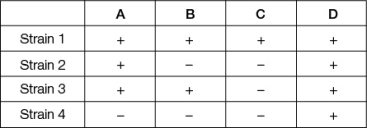Suppose that a certain wild-type bacteria can synthesize substance D, but various mutant strains cannot.We know that substance D is synthesized from substance X in a pathway that involves three intermediate substances (A, B, and C) , but we do not know the order of the steps in the pathway.The table shows four different mutant strains that have been tested for their ability to grow on the various substances.The "+" means that the strain can grow on that substance.The "‒" means that the strain cannot grow on that substance.  What is the most likely order of the pathway? (For example, A B C D indicates that substance A is converted to substance B, which is converted to substance C, which is converted to substance D.)
What is the most likely order of the pathway? (For example, A B C D indicates that substance A is converted to substance B, which is converted to substance C, which is converted to substance D.)
Definitions:
Patient Cancellations
The act of a patient informing a healthcare provider that they will not be able to attend a scheduled appointment.
Practitioner
A professional engaged in the practice of a particular health discipline or field of expertise.
Meetings
Gatherings of individuals or groups, usually for a specific purpose or agenda, often involving discussion, decision-making, or informational exchange.
Q9: Which statement about DNA linkage analysis is
Q13: Which mutation is least likely to be
Q65: The central dogma of molecular biology concerns
Q76: Egg and Fluffy are two genes in
Q81: The type of mutation most commonly observed
Q99: During _, the molecule _ recognizes which
Q113: Which statement about glycoproteins is true?<br>A) They
Q167: In the past, it was common for
Q202: One particular allele of a gene may
Q213: Refer to the table.In Drosophila, white (w),